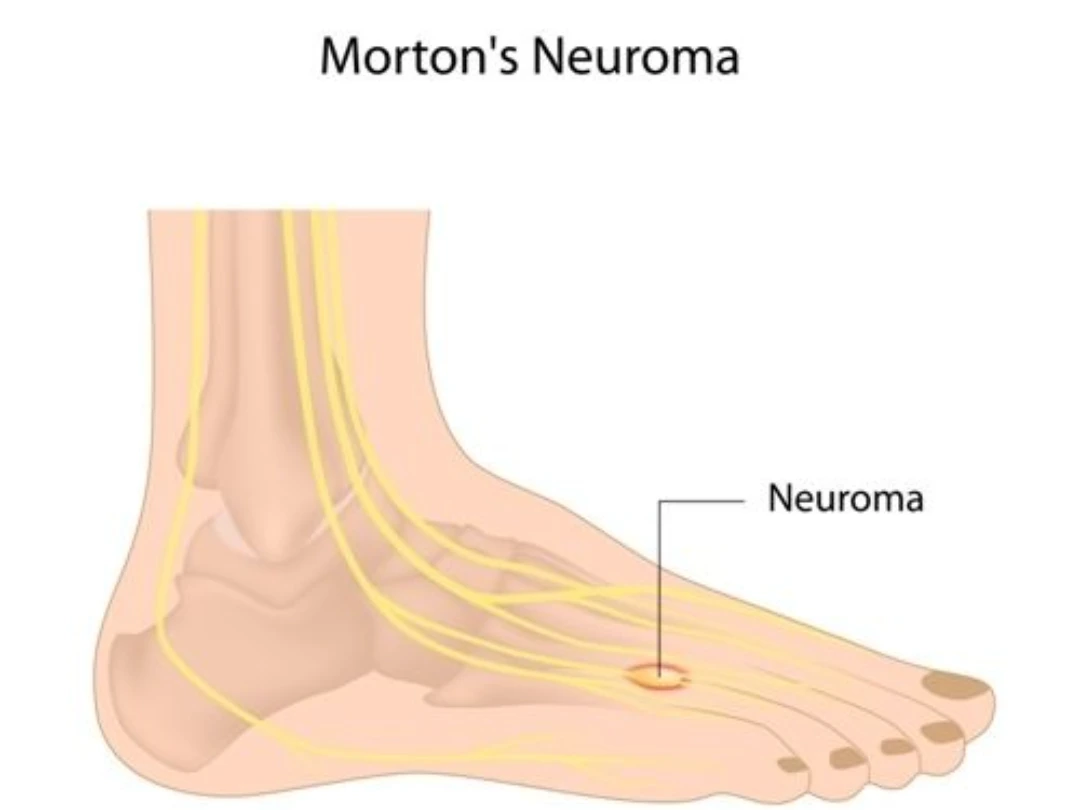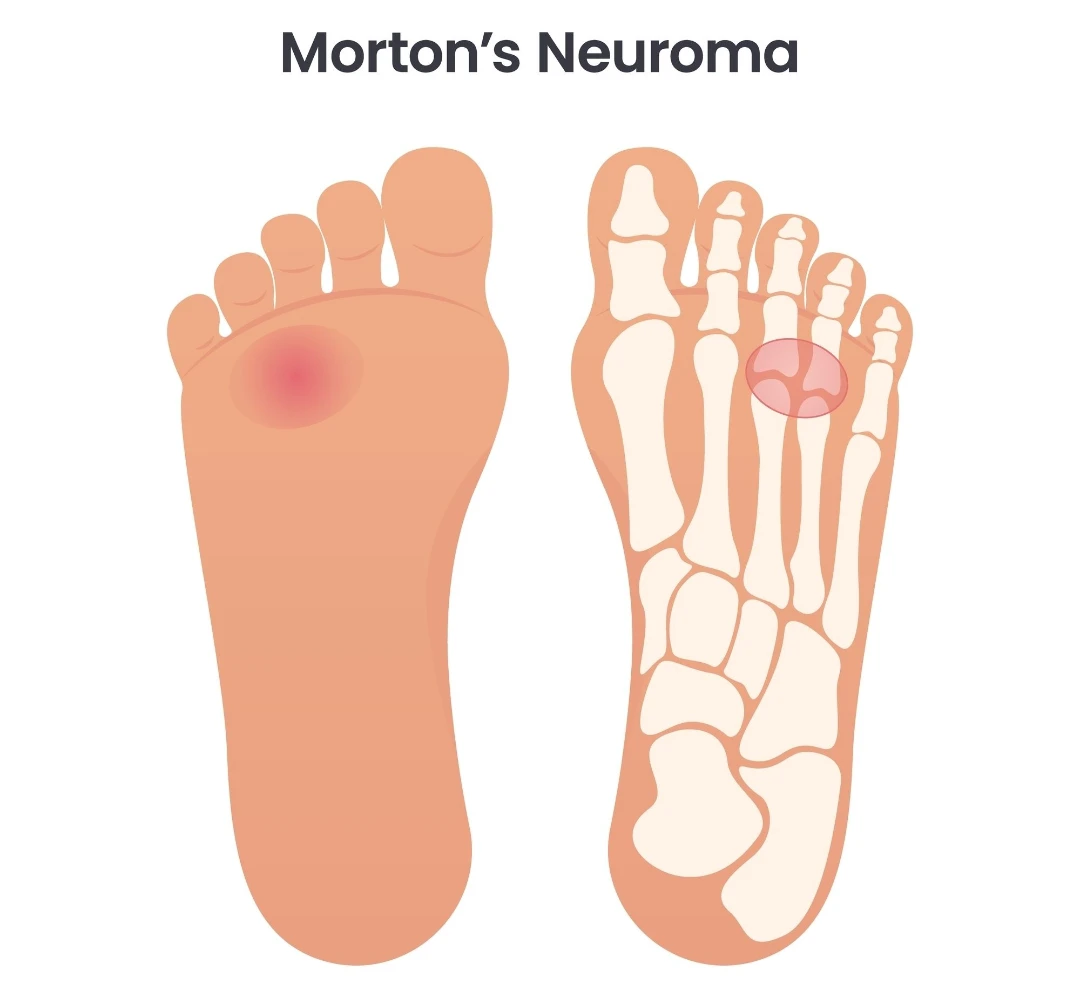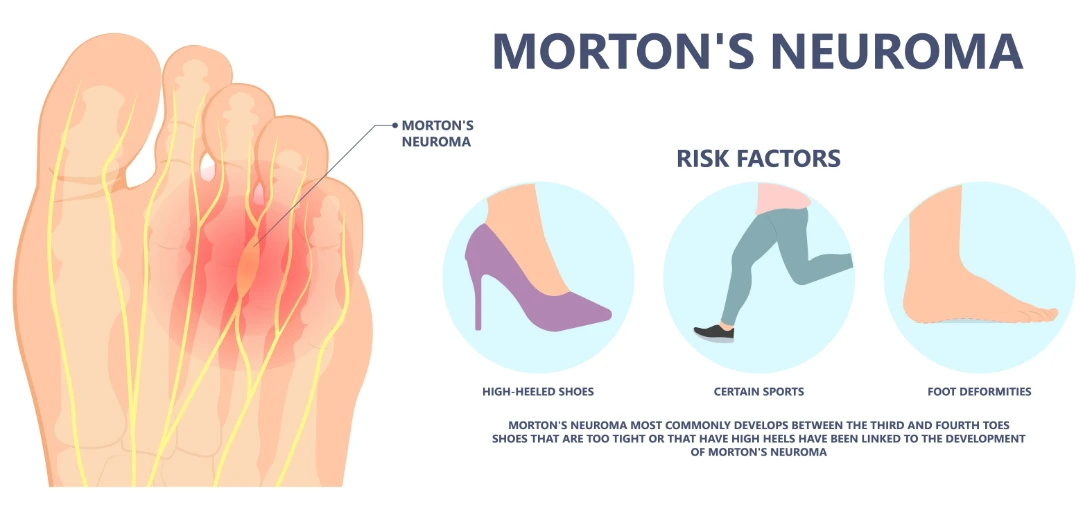Morton’s
Neuroma
- Home
- Conditions We Treat
- Foot & Ankle
- Morton’s Neuroma

What is
Morton’s Neuroma?
Morton’s Neuroma is a painful condition that affects the ball of the foot, most commonly between the third and fourth toes. It occurs when the tissue surrounding one of the nerves thickens– resulting in irritation and pressure. This thickening can cause sharp and burning pain, tingling or numbness in the toes.
Patients suffering from Morton’s Neuroma may feel as if there’s a pebble in their shoe or experience discomfort that worsens with walking or standing. Early diagnosis and treatment are crucial to manage symptoms and prevent the condition from worsening.
What causes Morton’s Neuroma?
Morton’s Neuroma is caused by the compression or irritation of a nerve in the ball of the foot, typically between the third and fourth toes. This pressure leads to the thickening of the tissue around the nerve, creating a neuroma, or benign growth. The repeated trauma or stress on this nerve results in inflammation and can trigger persistent pain.
Often, the condition develops due to the mechanics of the foot, such as improper foot alignment or abnormal motion patterns, which can place undue stress on the nerves. Over time, this continuous pressure damages the nerve, causing the characteristic symptoms associated with Morton’s Neuroma.

What are the symptoms of Morton’s Neuroma?
The symptoms of Morton’s Neuroma often develop gradually and can worsen over time. Common signs to watch for include:
- A sharp, burning pain in the ball of the foot.
- Tingling or numbness in the toes.
- Feeling like there’s a pebble or lump inside the shoe.
- Discomfort that worsens with walking or wearing tight shoes.
- A sensation of electric shocks or a cramping feeling in the toes.
Is Morton's Neuroma painful?
Yes, Morton’s Neuroma is often painful. The most common symptom is a sharp, burning pain in the ball of the foot, which can radiate into the toes. The pain often worsens with activities like walking or wearing tight shoes. Some people may also experience a cramping or tingling sensation. The discomfort can range from mild to severe– depending on the extent of nerve irritation or damage.

Who is at risk of Morton’s Neuroma in Singapore?
Certain factors make individuals more susceptible to developing Morton’s Neuroma, particularly those that involve repetitive pressure or strain on the feet. The common risk factors include:
- Wearing tight, narrow shoes or high heels frequently, which compresses the toes.
- Participating in high-impact sports such as running or tennis leads to repeated foot stress.
- Having foot deformities, like flat feet, high arches, or bunions, that alter foot mechanics.
- Engaging in activities or occupations that place consistent pressure on the forefoot.
- Being over the age of 40, as the condition tends to become more common with age.
How is Morton’s Neuroma diagnosed?
At Cove Orthopaedic, we diagnose Morton’s Neuroma using a thorough and personalised approach to ensure an accurate assessment;
- Physical examination: our specialist will carefully examine your foot, checking for pain, tenderness or any unusual mass between the toes.
- Symptom assessment: manipulation of your foot may be necessary to recreate the symptoms you’ve been experiencing, which helps pinpoint the exact location of the neuroma.
- X-rays: while X-rays don’t show the neuroma, they are often used to rule out other potential causes like fractures or arthritis.
- Ultrasound: this imaging technique helps us get a clear picture of the soft tissues, which is crucial for confirming the presence of the neuroma.
- MRI: MRI may be recommended to detect the size and location of the neuroma, which can guide tailoring the best treatment plan for you.
What are the treatment options for Morton’s Neuroma in Singapore?
At Cove Orthopaedic, we offer a variety of treatment options for Morton’s Neuroma, focusing on relieving pain, reducing nerve irritation and helping patients return to their normal activities. Here’s a detailed look at the available treatment options:
- Non-surgical treatments: for many patients, non-surgical treatments are effective in managing the symptoms of Morton’s Neuroma, particularly in the early stages.
- Footwear modification: one of the simplest and most effective steps is switching to shoes that offer more room for the toes, have lower heels and provide better arch support. Proper footwear can alleviate pressure on the affected nerve and reduce pain.
- Orthotic devices: custom orthotics or shoe inserts to provide better arch support and cushion the ball of the foot, which can help relieve pressure on the neuroma. These devices are tailored to the patient’s specific foot shape and condition.
- Padding: adding padding to shoes can further protect the area and reduce the compression on the nerve. This is often used in combination with orthotic devices to enhance comfort and support.
- Activity modification: reducing or avoiding activities that exacerbate the pain, such as running or standing for long periods, can give the nerve time to heal. Low-impact exercises, such as swimming or cycling, may be recommended as alternatives.
- Medications: over-the-counter anti-inflammatory medications, such as ibuprofen or naproxen, can help reduce pain and inflammation around the neuroma. These medications are most effective for managing mild to moderate symptoms.
- Steroid injections: for more severe pain, corticosteroid injections may be recommended to reduce inflammation directly at the site of the neuroma. This treatment can provide significant relief, though it is often used in conjunction with other non-surgical options.
- Radiofrequency ablation: If non-surgical treatments do not provide sufficient relief, there are minimally invasive options to consider. For example, radiofrequency ablation is one of the commonly used non-invasive procedures that uses radiofrequency waves to heat and deactivate the nerve fibers, which helps to stop the pain signals.
- Surgery: in severe cases where non-surgical and minimally invasive treatments are ineffective, surgery may be recommended. Neurectomy is the most common surgical procedure for Morton’s Neuroma. It involves removing the affected portion of the nerve, which permanently eliminates the source of pain. The surgery is typically done on an outpatient basis. After surgery, there may be some numbness in the toes, but this is usually a manageable side effect compared to the inconveniences induced by pain.
At Cove Orthopaedic, we take a personalised approach to Morton’s Neuroma treatment, as we carefully assess each patient’s condition and lifestyle to recommend the most appropriate and effective treatment plan. If you’re experiencing foot pain or suspect you may have Morton’s Neuroma, schedule an appointment with Cove Orthopaedic for thorough evaluation and personalised treatment options.
Frequently asked questions
Can Morton’s Neuroma heal on its own?
In some cases, symptoms of Morton’s Neuroma may improve with conservative measures like switching to more comfortable footwear or using orthotics. However, if left untreated, the condition can worsen, and surgery might eventually be needed for lasting relief.
How long does it take to recover from Morton’s Neuroma surgery?
Recovery from Morton’s Neuroma surgery typically takes a few weeks. Most patients can return home the same day, but full recovery may require several weeks of rest and rehabilitation, depending on the severity of the case and the surgical procedure used.
Can Morton’s Neuroma come back after treatment?
Yes, while treatment—whether surgical or non-surgical—is often successful, Morton’s Neuroma can sometimes recur, especially if the underlying causes, like wearing tight shoes or high heels, are not addressed. Post-treatment care and lifestyle changes can help reduce the risk of recurrence.
Is walking bad for Morton’s Neuroma?
Walking, especially in tight or improper shoes, can aggravate Morton’s Neuroma and increase pain. Wearing wider shoes with adequate cushioning can help minimise discomfort during walking, but activities that put pressure on the forefoot should be moderated.
How do I know if I need surgery for Morton’s Neuroma?
Surgery is usually considered when non-surgical treatments like orthotics, medications or injections fail to provide relief. If you have persistent pain and limited mobility despite trying conservative treatments, your doctor may recommend surgical options.










